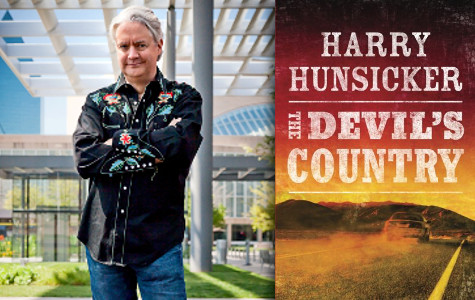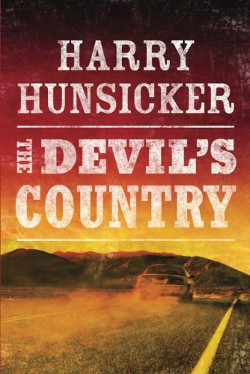
Harry Hunsicker is a 4th-generation native of Dallas and former executive vice-president of the Mystery Writers of America. A Shamus and Thriller Award nominee, he has also had a short story (“West of Nowhere”) selected for inclusion in the anthology The Best American Mystery Stories 2011 after initial publication in Ellery Queen Mystery Magazine. Mr. Hunsicker has written two series, one featuring Dallas PI Lee Henry Oswald and the other disgraced ex-cop Jon Cantrell. The Devil’s Country (available April 11, 2017) is his 7th novel.
Recently, Mr. Hunsicker took time out of his busy schedule to answer some questions about his inspiration for creating a new character and canvas, the importance of setting, and the ingenuity of his publisher, Thomas & Mercer.
What inspired you to write The Devil’s Country, and how did the process of establishing a new creative canvas compare to that of the series writing you’ve done recently?
I have always been drawn to the idea of being able to go anywhere at any time, just because. I think most people are to one degree or another. The concept of having no entanglements is appealing on a lot of levels. That is the essence of Arlo Baines. As the book progresses, we learn why he’s able to wander and, of course, that builds a great deal of sympathy for him as a character.
I am also fascinated by worlds that are hidden in plain sight, part of society yet separate (i.e., the Sky of Zion cult). Those two elements came together and inspired The Devil’s Country. I deliberately gave the main character no entanglements other than what was in his head. In my earlier series, the main characters always had sidekicks and friends who were part of their world. This time, I wanted someone who would fly solo, so to speak.
This book introduces a new protagonist, Arlo Baines. How does his tragic past influence his present day actions and motives—and in what ways does the duality of internal vs. external demons heighten suspense?
Six months before the story begins, Arlo’s family is murdered by three corrupt police officers. This is the single biggest influence in his life. He has lost the two most important aspects of who he is—his family and his profession. He is a man adrift on a path not of his own choosing. So, when he is presented with the opportunity to find two missing children (a boy and a girl, just like his own offspring), he really has no choice. In the book, the past (the internal demons) is explained slowly over the course of the entire narrative (the external demons), which draws out the suspense. (Hopefully!)
In what ways do you see Arlo as representing the “mysterious stranger” archetype, and how else are you able to take familiar constructs and make them fresh?
The mysterious stranger is most familiar to fans of Westerns—the stranger who arrives in town and administers justice. (Examples: High Plains Drifter, about half the Louis L’Amour books ever published, etc.) I think that by setting this type of character in the modern day, the old tropes become fresh. Here’s an interesting tidbit: I didn’t realize until I began doing press for the book that I had really written a Western. I saw everything through the lens of the current era, even though the character could be straight out of a John Wayne movie.

This story is set against the fictitious backdrop of Piedra Springs. In what ways do you find that setting enhances narrative, and how does real Texas justice (and culture) inform your depiction of place?
I have always been drawn to novels with a strong sense of place, such as the works of James Lee Burke where you can all but taste the gumbo and smell the bayou. Books are like movies without the pictures and sounds. The writer must create all that for the reader, and one of the best ways to accomplish this is to have vivid and memorable descriptions of the settings.
The Devil’s Country is set in a fictional area of west Texas—“somewhere in the badlands between Odessa and Sonora” is how I describe it. That’s hard country filled with hard people, and that influences much of what happens in the book as well as in real life. People in that part of the world are very self-reliant because they have to be. They are also used to administering their own justice—again, because oftentimes they have to.
You now publish through Amazon’s Thomas & Mercer imprint. Why is this a good fit for your work, and how do you view Amazon as being innovative within the industry?
Big smiley face for Thomas & Mercer. They are wonderful to work with, passionate about storytelling, storytellers, and selling a lot of books. Their biggest innovation is that they fully grasp who their audience is and tailor the selling of their products to best capture those readers.
Leave us with a teaser: what comes next?
I am kicking around two ideas at the moment: another Arlo Baines book and a standalone about a Texas crime family—sort of The Godfather meets J. R. Ewing.
To learn more or order a copy, visit:
opens in a new window![]() opens in a new window
opens in a new window![]() opens in a new window
opens in a new window![]()
Harry Hunsicker is the former executive vice-president of the Mystery Writers of America and the author of seven crime thrillers. His work has been short-listed for both the Shamus and Thriller Awards. Hunsicker's story “West of Nowhere,” originally published in Ellery Queen Mystery Magazine, was selected for inclusion in the anthology, The Best American Mystery Stories 2011. His latest novel The Devil's Country will be published in April 2017 by Thomas & Mercer.
John Valeri wrote the popular Hartford Books Examiner column for Examiner.com from 2009 – 2016. He can be found online at www.johnbvaleri.com and is featured in the Halloween-themed anthology Tricks and Treats, now available from Books & Boos Press.
